Effect of Hexagonal Boron nitride Nanopowder Reinforcement and Mixing Methods on Physical and Mechanical Properties of Self-Cured PMMA for Dental Applications
Abstract
1. Introduction
2. Materials and Methods
2.1. Specimens Preparation
2.2. Characterization
3. Results and Discussion
4. Conclusions
Funding
Acknowledgments
Conflicts of Interest
References
- Patras, M.; Naka, O.; Doukoudakis, S.; Pissiotis, A. Management of provisional restorations’ deficiencies: A literature review. J. Esthet. Restor. Dent. 2012, 24, 26–28. [Google Scholar] [CrossRef] [PubMed]
- Nigel Tom, T.; Uthappa, M.A.; Sunny, K.; Begum, F.; Nautiyal, M.; Tamore, S. Provisional restorations: An overview of materials used. J. Adv. Clin. Res. Insights. 2016, 3, 212–214. [Google Scholar] [CrossRef]
- Ireland, M.F.; Dixon, D.L.; Breeding, L.C.; Ramp, M.H. In vitro mechanical property comparison of four resins used for fabrication of provisional fixed restorations. J. Prosthet. Dent. 1998, 80, 158–162. [Google Scholar] [CrossRef]
- Lu, H.; Stansbury, J.W.; Nie, J.; Berchtold, K.A.; Bowman, C.N. Development of highly reactive mono-(meth) acrylates as reactive diluents for dimethacrylate-based dental resin systems. Biomaterials 2005, 26, 1329–1336. [Google Scholar] [CrossRef]
- Ruddell, D.E.; Maloney, M.M.; Thompson, J.Y. Effect of novel filler particles on the mechanical and wear properties of dental composites. Dent. Mater. 2002, 18, 72–80. [Google Scholar] [CrossRef]
- Xu, H.H.; Quinn, J.B.; Smith, D.T.; Antonucci, J.M.; Schumacher, G.E.; Eichmiller, F.C. Dental resin composites containing silica-fused whiskers—effects of whisker-to-silica ratio on fracture toughness and indentation properties. Biomaterials 2002, 23, 735–742. [Google Scholar] [CrossRef]
- Loza-Herraro, M.A.; Rueggeberg, F.A.; Caughman, W.F.; Schuster, G.S.; Lefebvre, C.A.; Gardner, F.M. Effect of heating delay on conversion and strength of a post-cured resin composite. J. Dent. Res. 1998, 77, 426–431. [Google Scholar] [CrossRef]
- Duncan, J.P.; Freilich, M.A.; Latvis, C.J. Fiber-reinforced composite framework for implant-supported overdentures. J. Prosthet. Dent. 2000, 84, 200–204. [Google Scholar] [CrossRef]
- Rodrigues, A.H. Metal reinforcement for implant-supported mandibular overdentures. J. Prosthet. Dent. 2000, 83, 511–513. [Google Scholar] [CrossRef]
- Jagger, D.C.; Harrison, A.; Jandt, K.D. The reinforcement of dentures. J. Oral. Rehabil. 1999, 26, 185–194. [Google Scholar] [CrossRef]
- Astudillo-Rubio, D.; Delgado-Gaete, A.; Bellot-Arcís, C.; Montiel-Company, J.M.; Pascual-Moscardí, A.; Almerich-Silla, J.M. Mechanical properties of provisional dental materials: A systematic review and meta-analysis. PLoS ONE 2018, 13, e0193162. [Google Scholar] [CrossRef]
- Chalissery, V.P.; Marwah, N.; Almuhaiza, M.; AlZailai, A.M.; Chalisserry, E.P.; Bhandi, S.H.; Anil, S. Study of the mechanical properties of the novel zirconia-reinforced glass ionomer cement. J. Contemp. Dent. Pract. 2016, 17, 394–398. [Google Scholar] [PubMed]
- Lohbauer, U. Dental Glass Ionomer Cements as Permanent Filling Materials?—Properties, Limitations and Future Trends. Materials 2010, 3, 76–96. [Google Scholar] [CrossRef]
- Greim, J.; Schwetz, K.A. Boron Carbide, Boron Nitride, and Metal Borides, Ullmann’s Encyclopedia of Industrial Chemistry; Wiley-VCH: Weinheim, Germany, 15 December 2006; Pub2. [Google Scholar]
- Engler, M. Hexagonal Boron Nitride (hBN)—Applications from Metallurgy to Cosmetics. Ceram. Forum Int. 2007, 84, E49–E53. [Google Scholar]
- Zhi, C.; Bando, Y.; Tang, C.; Kuwahara, H.; Golberg, D. Large-scale fabrication of boron nitride nanosheets and their utilization in polymeric composites with improved thermal and mechanical properties. Adv. Mater. 2009, 21, 2889–2893. [Google Scholar] [CrossRef]
- Wang, X.; Pakdel, A.; Zhang, J.; Weng, Q.; Zhai, T.; Zhi, C.; Golberg, D.; Bando, Y. Large-surface-area BN nanosheets and their utilization in polymeric composites with improved thermal and dielectric properties. Nanoscale Res. Lett. 2012, 7, 662–668. [Google Scholar] [CrossRef]
- Yokoi, A.; Tan, W.K.; Kuroda, T.; Kawamura, G.; Matsuda, A.; Muto, H. Design of Heat-Conductive hBN–PMMA Composites by Electrostatic Nano-Assembly. Nanomaterials 2020, 10, 134. [Google Scholar] [CrossRef]
- Sharma, S.; Setia, P.; Chandra, R.; Thakur, N. Experimental and molecular dynamics study of boron nitride nanotube-reinforced polymethyl methacrylate composites. J. Compos. Mater. 2020, 54, 3–11. [Google Scholar] [CrossRef]
- Zhi, C.Y.; Bando, Y.; Wang, W.L.; Tang, C.C.; Kuwahara, H.; Golberg, D. Mechanical and Thermal Properties of Polymethyl Methacrylate-BN Nanotube Composites. J. Nanomater. 2008, 2008, 642036. [Google Scholar] [CrossRef]
- Bisht, A.; Kumar, V.; Chandra Maity, P.; Lahiri, I.; Lahiri, D. Strong and transparent PMMA sheet reinforced with amine functionalized BN nanoflakes for UV-shielding application. Compos. Part B Eng. 2019, 176, 107274–107281. [Google Scholar] [CrossRef]
- Nuran, A.; Suleyman, A. Composition for Preventing the Dental Calculus Formation. Eur. Pat. 2712656 A2, 2014. [Google Scholar]
- Degrazia, F.W.; Leitune, V.C.B.; Samuel, S.M.W.; Collares, F.M. Boron nitride nanotubes as novel fillers for improving the properties of dental adhesives. J. Dent. 2017, 62, 85–90. [Google Scholar] [CrossRef] [PubMed]
- Alhareb, A.O.; Ahmad, Z.A. Effect of Al2O3/ZrO2 reinforcement on the mechanical properties of PMMA denture base. J. Reinf. Plast. Compos. 2011, 30, 86–93. [Google Scholar] [CrossRef]
- Duan, G.; Zhang, C.; Li, A.; Yang, X.; Lu, L.; Wang, X. Preparation and Characterization of Mesoporous Zirconia Made by Using a Poly (methyl methacrylate) Template. Nanoscale Res. Lett. 2008, 3, 18–22. [Google Scholar] [CrossRef] [PubMed]
- Geick, R.; Perry, C.H.; Rupprecht, G. Normal Modes in Hexagonal Boron Nitride. Phys. Rev. 1966, 146, 543–547. [Google Scholar] [CrossRef]
- Ikeda, T.; Kawate, Y.; Hirai, Y. Formation of cubic boron nitride films by arc—like plasma—enhanced ion plating method. J. Vac. Sci. Technol. 1990, 8, 3168–3174. [Google Scholar] [CrossRef]
- Rand, M.J.; Roberts, J. Preparation and Properties of Thin Film Boron Nitride. J. Electrochem. Soc. 1968, 115, 423–429. [Google Scholar] [CrossRef]
- Deshpandey, N.C.; Doerr, H.J.; Bunshah, R.F.; Chopra, K.L.; Vankar, V. Preparation and properties of cubic boron nitride coatings. Thin Solid Film. 1987, 153, 487–496. [Google Scholar]
- Nakamura, K. Preparation and Properties of Amorphous Boron Nitride Films by Molecular Flow Chemical Vapor Deposition. J. Electrochern. Soc. 1985, 132, 1757–1762. [Google Scholar] [CrossRef]
- Seidel, S.H.; Reichelt, K.; Schaal, W.; Dimigen, H. The preparation of cubic boron nitride films by reactive diode sputtering. Thin Solid Film. 1987, 151, 243–249. [Google Scholar] [CrossRef]
- Chopra, K.L.; Agarwal, V.; Vankar, V.D.; Deshpandey, C.V.; Bunshah, R.E. Synthesis of cubic boron nitride films by activated reactive evaporation of H3BO3. Thin Solid Film. 1985, 126, 307–312. [Google Scholar] [CrossRef]
- Rye, R.R. Hot filament activated chemical vapor deposition of boron nitride. J. Vac. Sci. Technol. A 1991, 8, 1099–1103. [Google Scholar] [CrossRef]
- Satou, M.; Yamaguchi, K.; Andoh, Y.; Suzuki, Y.; Matsuda, K.; Fujimoto, F. Nitride film formation by ion and vapor deposition. Nucl. Instrum. Methods. B 1985, 7, 910–914. [Google Scholar] [CrossRef]
- Reham, M.A. Evaluation of polymethyl methacrylate resin mechanical properties with incorporated halloysite nanotubes. J. Adv. Prosthodont. 2016, 8, 167–171. [Google Scholar]
- Vojdani, M.; Bagheri, R.; Khaledi, A.A. Effects of aluminum oxide addition on the flexural strength, surface hardness, and roughness of heat-polymerized acrylic resin. J. Dent. Sci. 2012, 7, 238–244. [Google Scholar] [CrossRef]
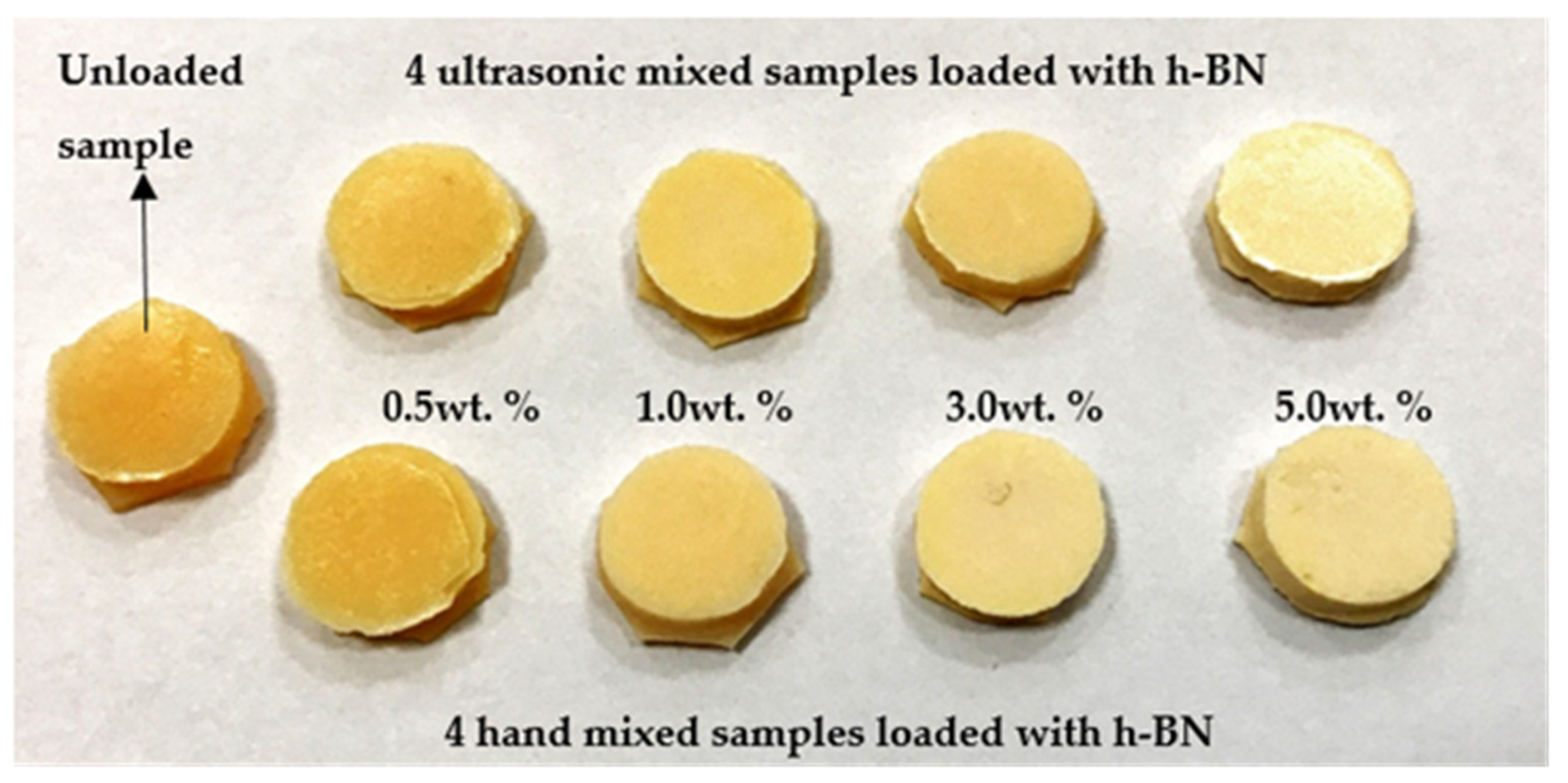
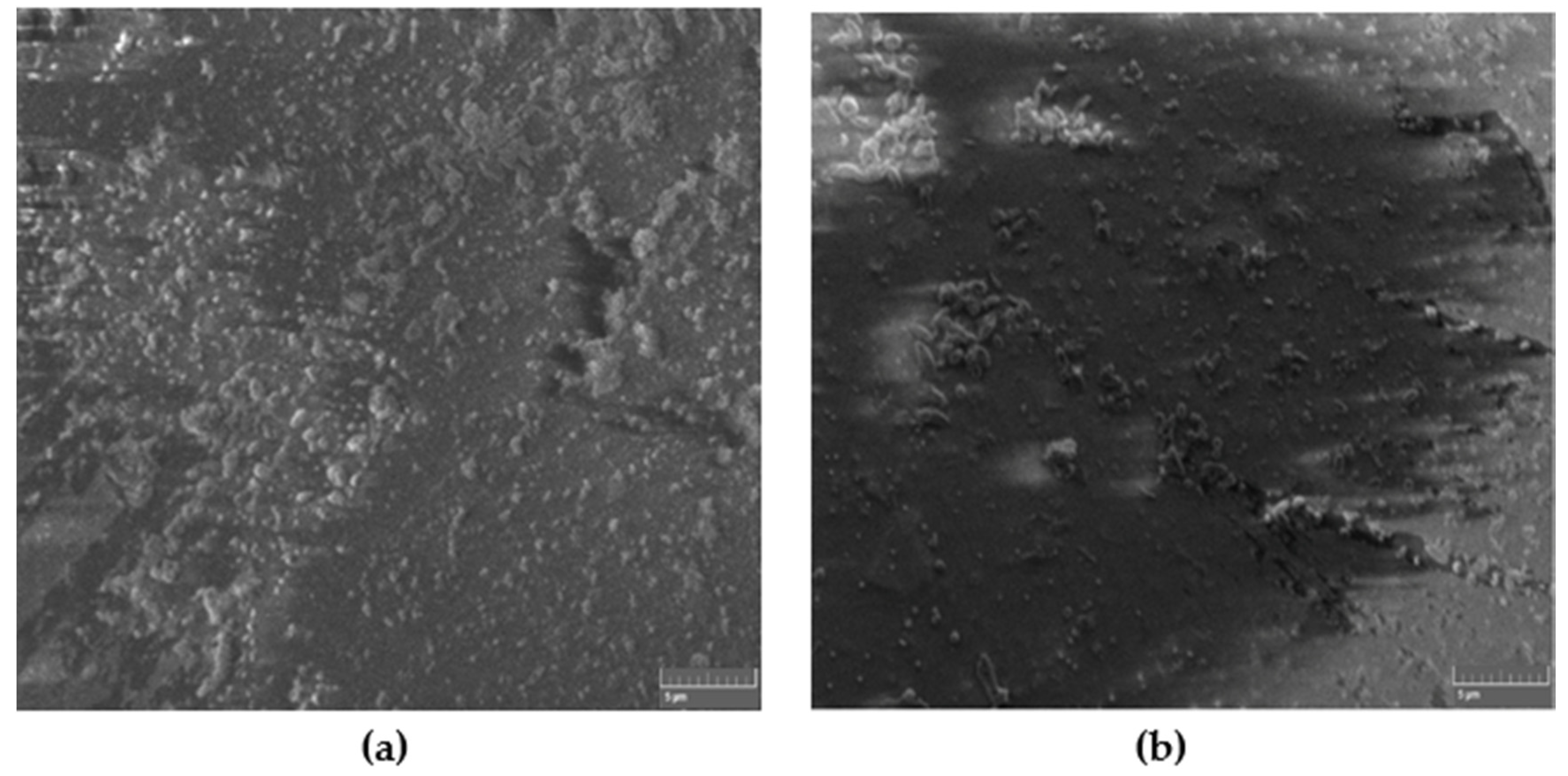
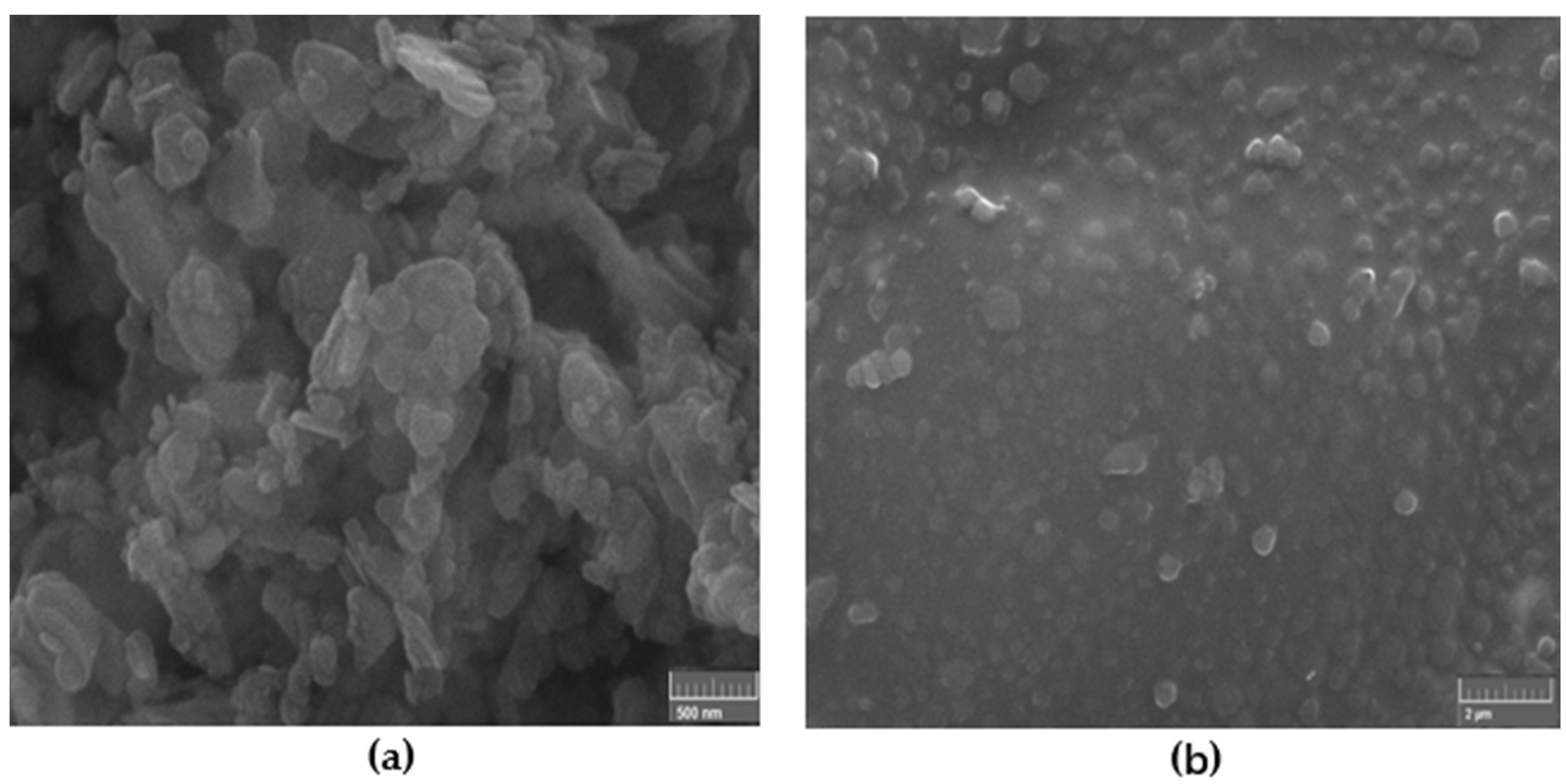
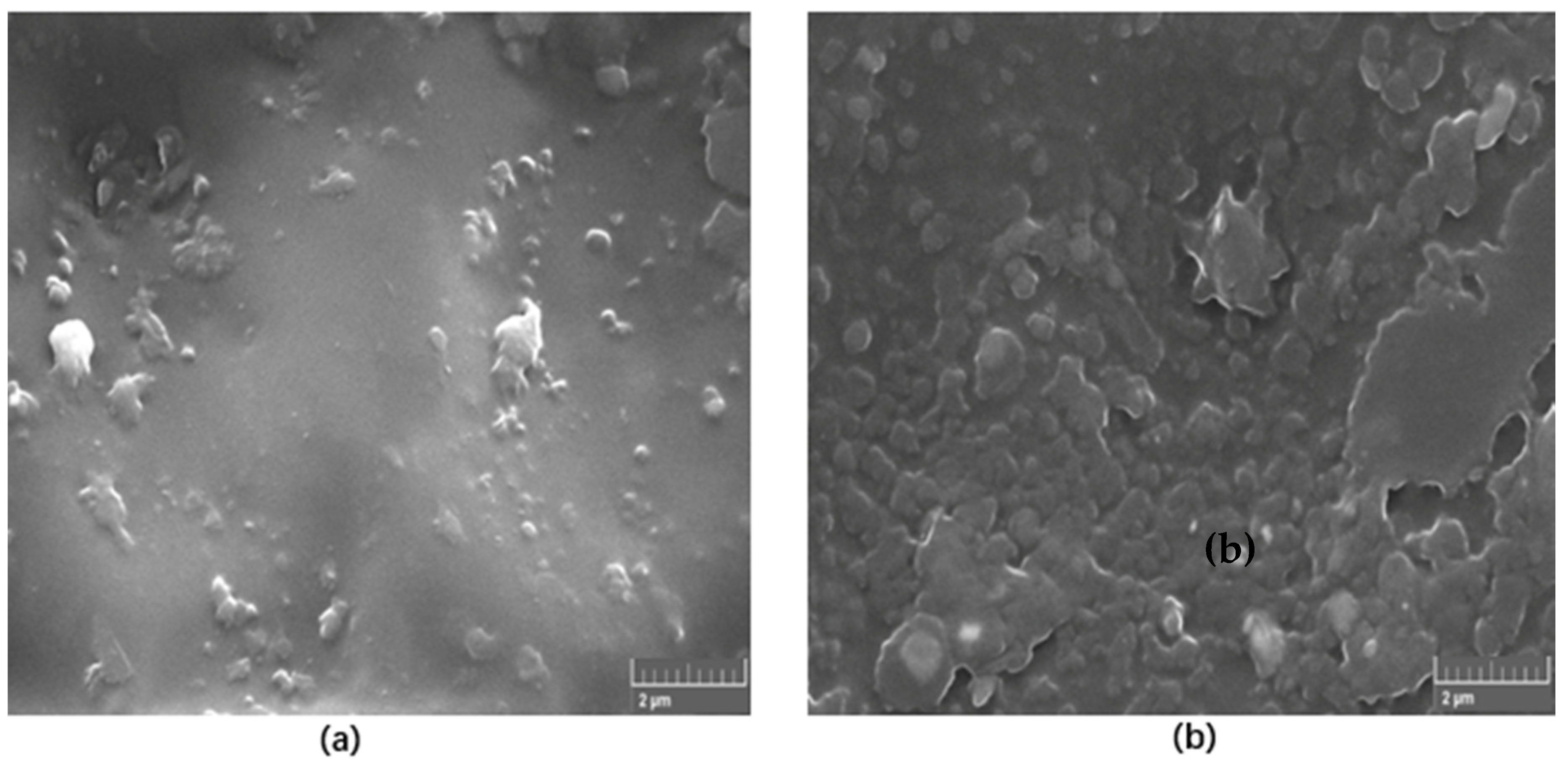
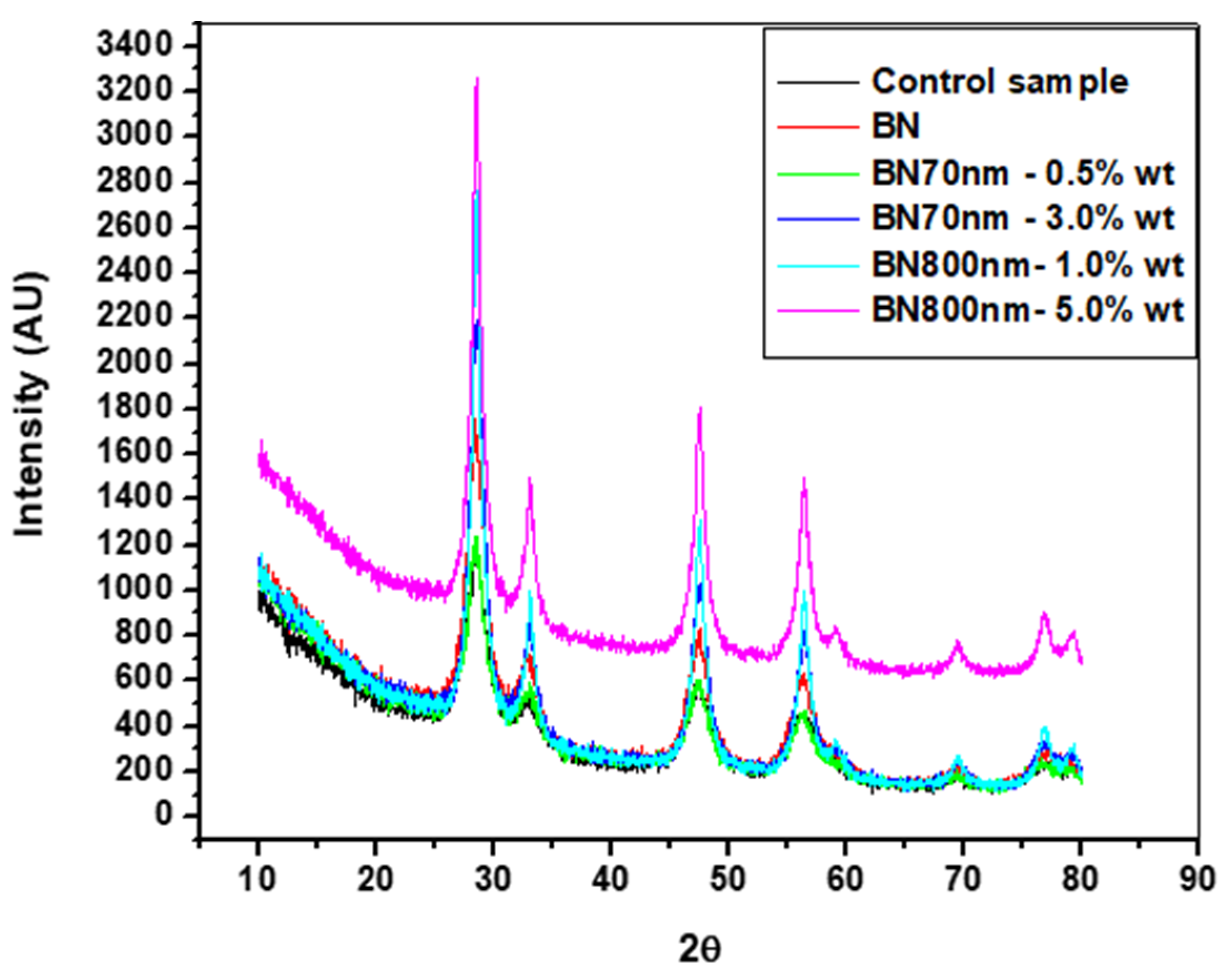
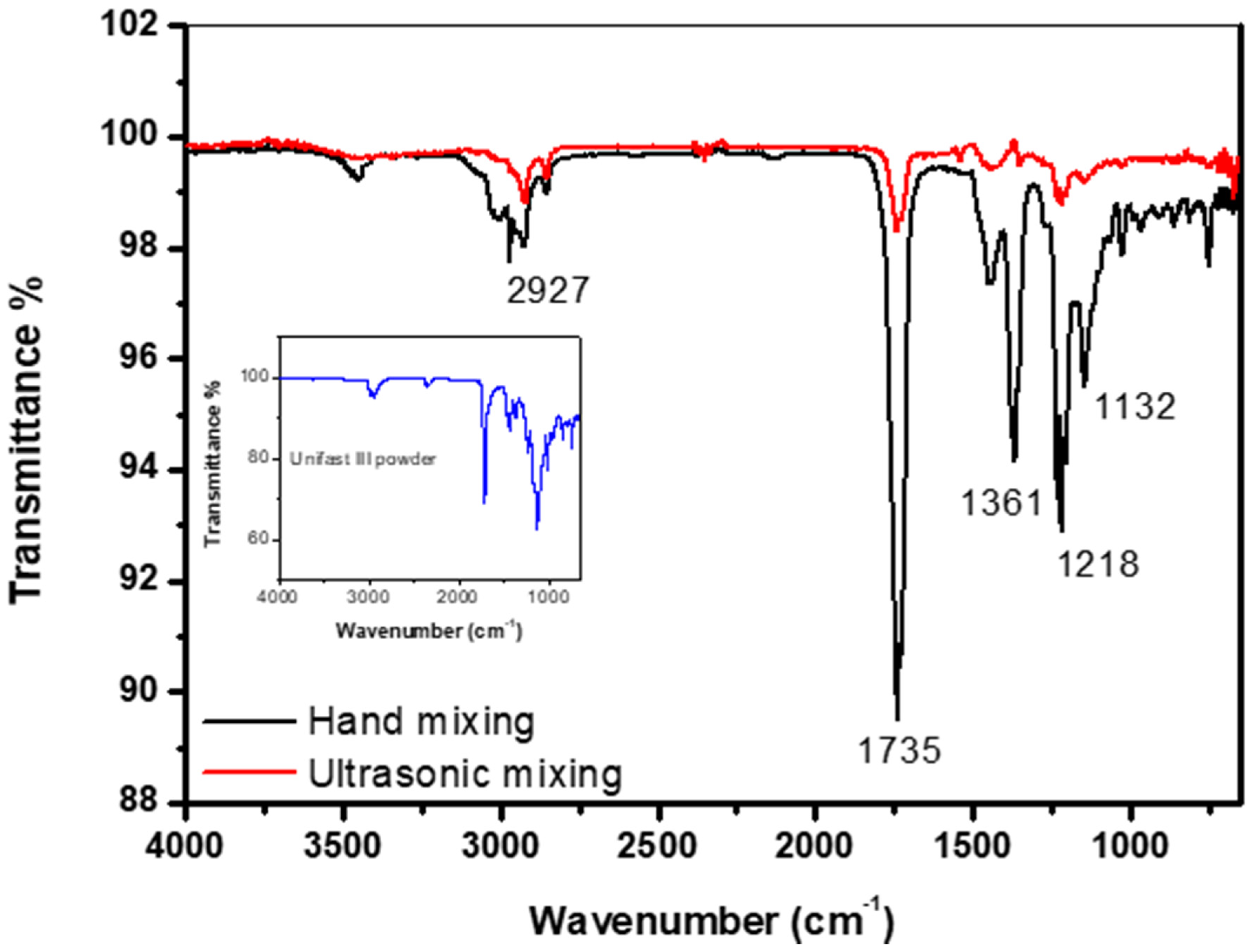

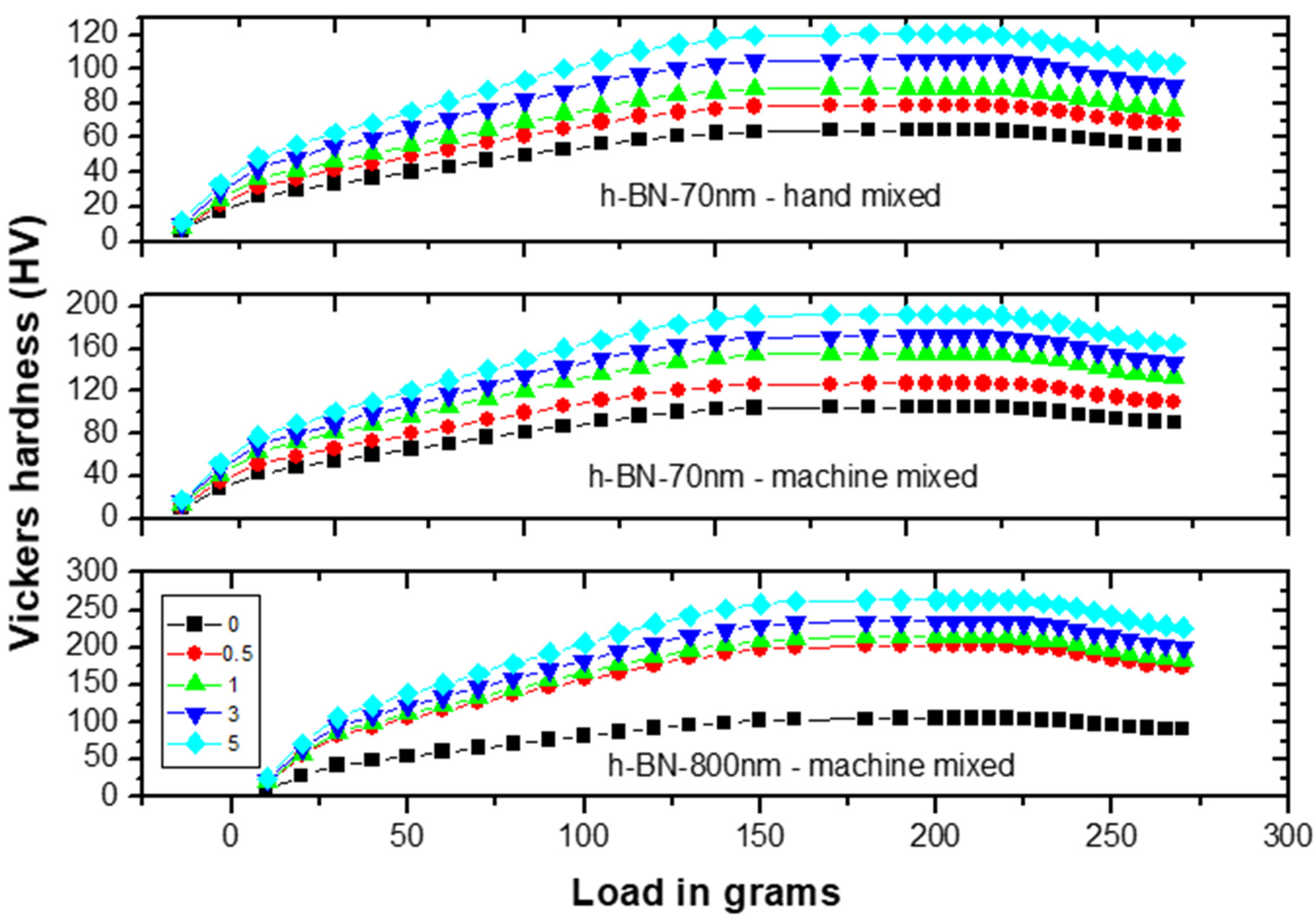

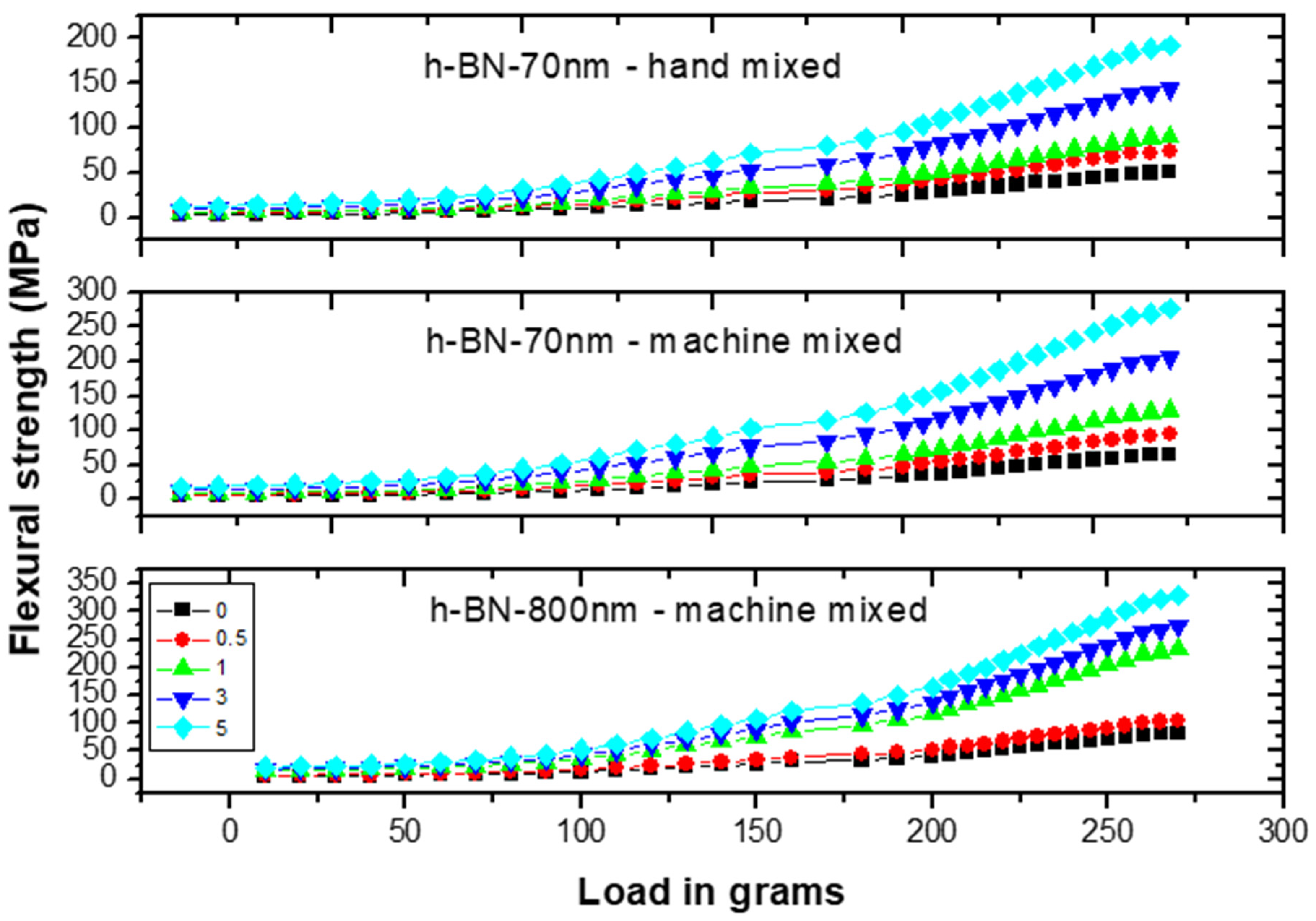
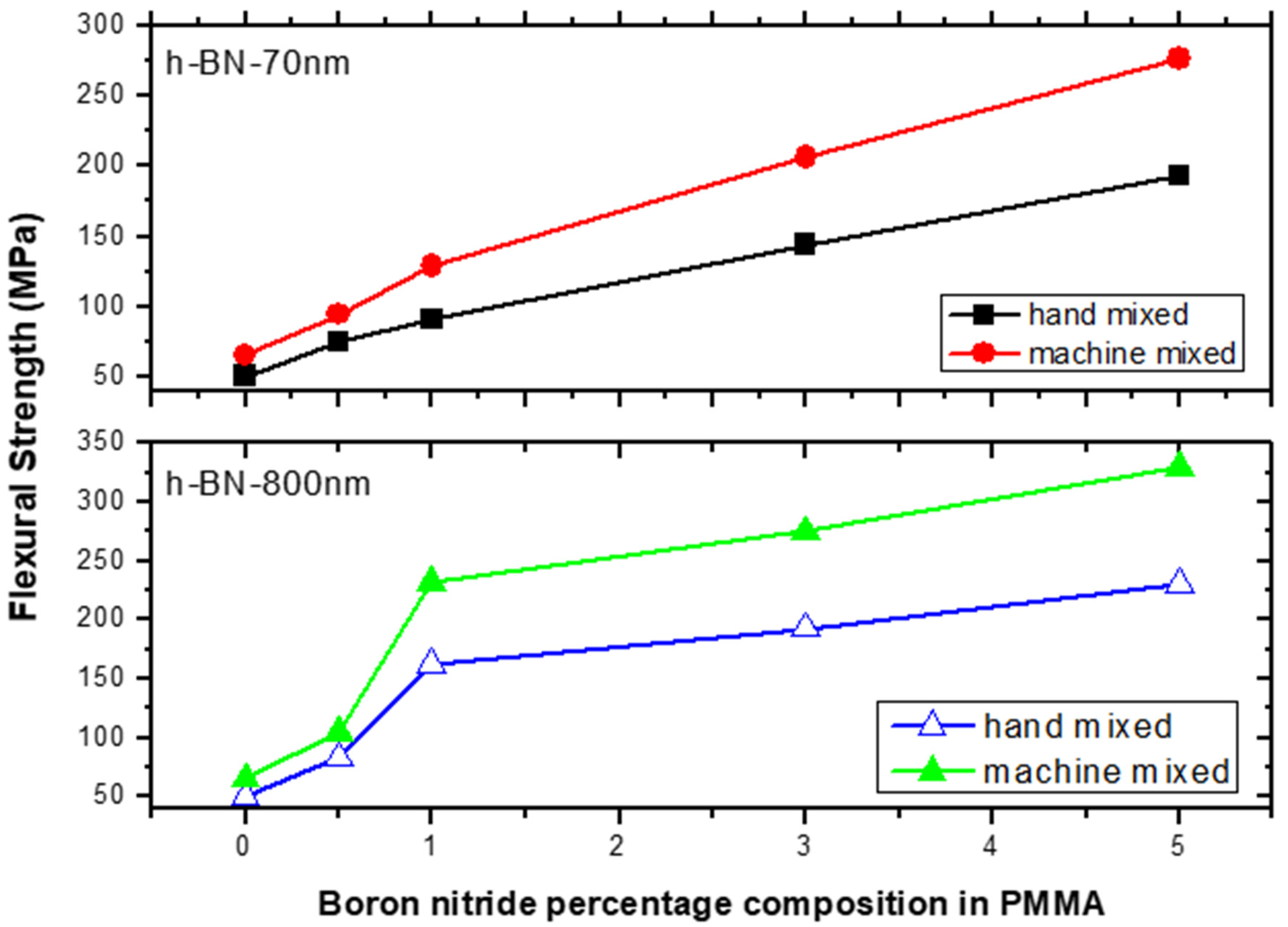
© 2020 by the author. Licensee MDPI, Basel, Switzerland. This article is an open access article distributed under the terms and conditions of the Creative Commons Attribution (CC BY) license (http://creativecommons.org/licenses/by/4.0/).
Share and Cite
Alqahtani, M. Effect of Hexagonal Boron nitride Nanopowder Reinforcement and Mixing Methods on Physical and Mechanical Properties of Self-Cured PMMA for Dental Applications. Materials 2020, 13, 2323. https://doi.org/10.3390/ma13102323
Alqahtani M. Effect of Hexagonal Boron nitride Nanopowder Reinforcement and Mixing Methods on Physical and Mechanical Properties of Self-Cured PMMA for Dental Applications. Materials. 2020; 13(10):2323. https://doi.org/10.3390/ma13102323
Chicago/Turabian StyleAlqahtani, Mana. 2020. "Effect of Hexagonal Boron nitride Nanopowder Reinforcement and Mixing Methods on Physical and Mechanical Properties of Self-Cured PMMA for Dental Applications" Materials 13, no. 10: 2323. https://doi.org/10.3390/ma13102323
APA StyleAlqahtani, M. (2020). Effect of Hexagonal Boron nitride Nanopowder Reinforcement and Mixing Methods on Physical and Mechanical Properties of Self-Cured PMMA for Dental Applications. Materials, 13(10), 2323. https://doi.org/10.3390/ma13102323




